
The Boeing B-29 Superfortress is an American four-engined propeller-driven heavy bomber designed by Boeing and flown primarily by the United States during World War II and the Korean War. Named in allusion to its predecessor, the B-17 Flying Fortress, the Superfortress was designed for high-altitude strategic bombing but also excelled in low-altitude night incendiary bombing and in dropping naval mines to blockade Japan. B-29s dropped the atomic bombs on Hiroshima and Nagasaki and became the only aircraft that has ever used nuclear weapons in combat.

Preston Thomas Tucker was an American automobile entrepreneur.
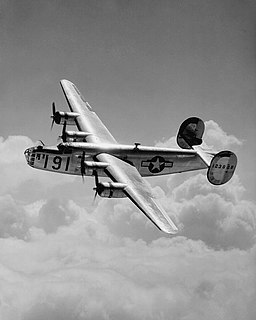
The Consolidated B-24 Liberator is an American heavy bomber, designed by Consolidated Aircraft of San Diego, California. It was known within the company as the Model 32, and some initial production aircraft were laid down as export models designated as various LB-30s, in the Land Bomber design category.

The Bell Aircraft Corporation was an American aircraft manufacturer, a builder of several types of fighter aircraft for World War II but most famous for the Bell X-1, the first supersonic aircraft, and for the development and production of many important civilian and military helicopters. Bell also developed the Reaction Control System for the Mercury Spacecraft, North American X-15, and Bell Rocket Belt. The company was purchased in 1960 by Textron, and lives on as Bell Textron.

Heavy bombers are bomber aircraft capable of delivering the largest payload of air-to-ground weaponry and longest range of their era. Archetypal heavy bombers have therefore usually been among the largest and most powerful military aircraft at any point in time. In the second half of the 20th century, heavy bombers were largely superseded by strategic bombers, which were often smaller in size, but had much longer ranges and were capable of delivering nuclear bombs.

Albert Kahn was an American industrial architect. He was accredited the architect of Detroit and designed industrial plant complexes such as the Ford River Rouge automobile complex. He designed the construction of Detroit skyscrapers and office buildings as well as mansions in the city suburbs. He led an organization of hundreds of architect associates and in 1937, designed 19% of all architect-designed industrial factories in the United States. Under a unique contract in 1929, Kahn established a design and training office in Moscow, sending twenty-five staff there to train Soviet architects and engineers, and to design hundreds of industrial buildings under their first five-year plan. They trained more than 4,000 architects and engineers using Kahn's concepts. In 1943, the Franklin Institute posthumously awarded Kahn the Frank P. Brown Medal.

The Wright R-3350 Duplex-Cyclone is a twin-row, supercharged, air-cooled, radial aircraft engine with 18 cylinders displacing nearly 55 L. Power ranged from 2,200 to over 3,700 hp, depending on the model. Developed before World War II, the R-3350's design required a long time to mature before finally being used to power the Boeing B-29 Superfortress. After the war, the engine had matured sufficiently to become a major civilian airliner design, notably in its turbo-compound forms, and was used in the Lockheed L-1049 Super Constellation airliners into the 1990s. The engine is commonly used on Hawker Sea Fury and Grumman F8F Bearcat Unlimited Class Racers at the Reno Air Races. Its main rival was the 71.5 L, 4,300 hp (3,200 kW) Pratt & Whitney R-4360 Wasp Major, first run some seven years after the Duplex-Cyclone's beginnings.
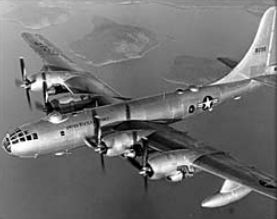
The Boeing B-50 Superfortress is an American strategic bomber. A post–World War II revision of the Boeing B-29 Superfortress, it was fitted with more powerful Pratt & Whitney R-4360 radial engines, stronger structure, a taller tail fin, and other improvements. It was the last piston-engined bomber built by Boeing for the United States Air Force, and was further refined into Boeing's final such design, the B-54. Though not as well known as its direct predecessor, the B-50 was in USAF service for nearly 20 years.
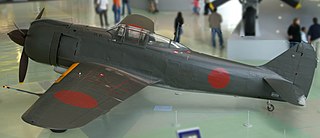
The Kawasaki Ki-100 (キ100) is a single-seat single-engine monoplane fighter aircraft used by the Imperial Japanese Army Air Service during World War II. The Japanese Army designation was "Type 5 Fighter". It was not assigned an Allied code name.

The Boeing B-29 Superfortress was an aircraft produced in many experimental and production models.

Tootsie Roll Industries is an American manufacturer of confectionery. Its best-known products have been Tootsie Rolls and Tootsie Pops. Tootsie Roll Industries currently markets its brands internationally in Canada, Mexico, and over 75 other countries.
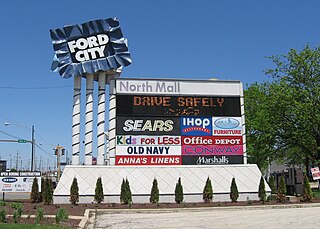
Ford City Mall is a shopping center located on the Southwest Side of Chicago in the West Lawn neighborhood at 76th Street and Cicero Avenue. Opened in 1965, Ford City is the largest enclosed mall in Chicago outside of downtown. Anchored by JCPenney, the mall contains more than 135 stores and restaurants including Applebee’s, Bath & Body Works, The Children’s Place, Foot Locker, Zales Jewelers, Marshalls, Old Navy, Victoria’s Secret/PINK, and Ross Dress for Less. There are several out parcels including a 14-theater AMC Theatres. Ford City Mall is managed by Mid-America Asset Managements.
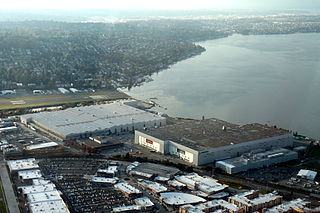
The Boeing Company's Renton, Washington Factory is a facility where the Boeing 737 MAX airliner is built. Current production includes the 737 MAX 7, 737 MAX 8, 737 MAX 9, and 737 MAX 10 models. The floor space covered is 1.1 million square feet.

The 444th Air Expeditionary Wing is a provisional unit of the United States Air Force assigned to Air Combat Command to activate or inactivate as needed. It was last activated in 2003.
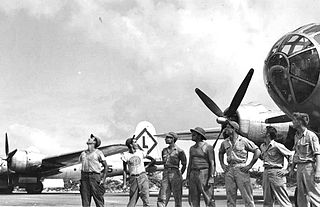
The 331st Bombardment Group is an inactive United States Air Force unit. It was last assigned to the 315th Bombardment Wing, being stationed at Northwest Field, Guam. It was inactivated on 15 April 1946.

The XXI Bomber Command was a unit of the Twentieth Air Force in the Mariana Islands for strategic bombing during World War II.

The Bombing of Yawata on the night of 15/16 June 1944 was the first air raid on the Japanese home islands conducted by United States Army Air Forces (USAAF) strategic bombers during World War II. The raid was undertaken by 75 Boeing B-29 Superfortress heavy bombers staging from bases in China. Only 47 of these aircraft dropped bombs near the raid's primary target, the Imperial Iron and Steel Works at Yawata in northern Kyūshū, and little damage was caused. Five B-29s were lost in accidents during the operation and two were destroyed by Japanese aircraft.
The Bombing of Chiba in World War II was part of the strategic bombing campaign waged by the United States of America against military and civilian targets and population centers during the Japan home islands campaign in the closing stages of World War II, and included two separate air raids in 1945. The second, and larger, air raid of July 6, 1945 is also referred to as the “Tanabata Air Raid”, as it occurred on the night of a traditional festival.

The Wild Blue Yonder is a 1951 war film directed by Allan Dwan. The film stars Wendell Corey, Vera Ralston, Forrest Tucker and Phil Harris. Wild Blue Yonder deals with the Boeing B-29 Superfortress air raids on Japan during World War II.

















